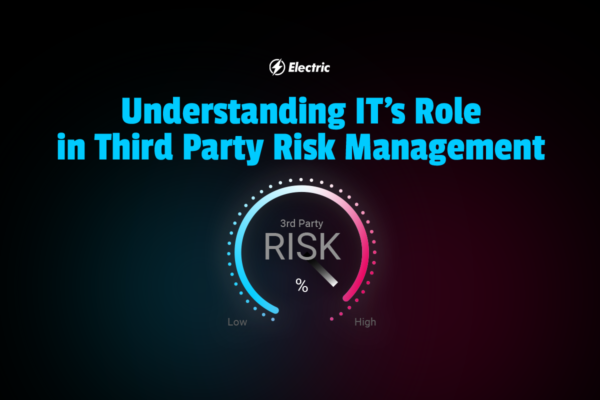
As supply chain infrastructure becomes increasingly globalized and interconnected, companies have to reckon with the many security risks that come with the territory. Leveraging a well-designed, IT-driven third party risk management program is one of the best ways to stay ahead of the curve, and keep your organization’s sensitive information secure.
In this article, we’ll discuss the following key points:
- What is third-party risk?
- What is third-party risk management (TPRM)?
- Why is TPRM so important?
- What role does IT play?
With a better understanding of how IT fits into supply chain security, you’ll be equipped to make optimal business decisions moving forward.
What is Third-Party Risk?
A third-party vendor is simply any person or company that provides services for another company (or that company’s customers). This can include a variety of entities called a number of different things—suppliers, distributors, service providers, partners, affiliates, brokers, distributors, resellers, agents, etc.
Nowadays, an organization may partner with scores of third-party vendors, from SaaS companies to law firms. Sometimes it may be easy to forget that a part of your business is actually managed by a third-party provider. For example, if you use Gmail or Microsoft Outlook, use a CRM from Salesforce or HubSpot, or use an internal communication tool like Slack or Zoom, then you are actually taking advantage of services provided by a third-party vendor.
Logically, “third-party risk” refers to the security and other risks that arise from sharing sensitive or confidential data with an external actor. Of course, third-party risk has become more and more of a concern as modern organizations leverage these vendors to optimize and streamline business processes.
What is Third-Party Risk Management (TPRM)?
Third-party risk management, aka TPRM, is the process of analyzing the risks associated with utilizing third-party vendors. It involves assessing who has access to your organization’s intellectual property, data, operations, finances, and customer information.
The primary component of an effective third-party risk management strategy is due diligence; in other words, investing in a comprehensive investigative process to determine if a third-party provider is suitable for a given task, especially in terms of security compliance. Moreover, due diligence in the context of TPRM is not a “one and done” action. It must be an ongoing initiative, since the world of cybersecurity is in a constant state of flux. What is an effective security measure one day may be obsolete the next.
Ultimately, the purpose of any third-party risk management program is to reduce the risk of security breaches, malicious data extraction, damaging operational failures, and other negative outcomes.
Why is Third Party Risk Management Important?
Third-party risk management is absolutely essential in today’s landscape for cutting costs, mitigating risks, and enhancing corporate reputations. A strong TPRM strategy will greatly reduce the negative impact that your company’s technology business decisions may have on both your customers and your financial solvency.
The importance of third-party risk management is especially evident when you consider recent examples of malicious attacks on poorly managed supply chains. For instance, lax, ineffective protocols at an HVAC vendor contributed to the 2014 security breach suffered by Target. In 2017, Equifax pointed to a flaw in external software it was using as the catalyst to a major data breach. Also in 2017, the Paradise Papers (13 million+ files detailing offshore tax avoidance by powerful organizations and individuals) were leaked to a German newspaper. The “weakest link” in that breach was a law firm.
It’s important to note that these are not isolated cases. A June 2020 survey on third-party risk found that:
- 80% of organizations have experienced a third-party-related data breach in the past 12 months
- 77% of organizations have “limited visibility” around their third-party vendors
- Companies experience, on average, 2.7 data breaches per year
With statistics like these, it’s no wonder that according to a December 2018 report from the Ponemon Institute, “lack of controls over third-party access to sensitive and confidential data” was a major security concern among IT professionals.
What Role Does IT Play in Preventing Supply Chain Attacks?
With third-party risk such a major concern, how can IT assist organizational leaders to mitigate (and in some cases even eliminate) such potential security hazards? Here are 3 roles IT can play in risk management and security breach prevention:
1. Automation
Automating your third-party risk management program enables you to create a standardized framework which can be applied to all third parties, whether currently partnered with your company or not. A few of the benefits of third-party risk management automation include:
- Enhanced third-party management flexibility
- Consistent metrics and reporting
- More detailed and organized data collection techniques
- Better data-driven decisions
- Increased third-party accountability
- Improved risk assessment and mitigation
By leveraging new tools and technologies that automate the data collection and analytics process, you’ll be able to allocate the bulk of your resources toward operational areas of highest impact.
2. Independent Risk Assessment
Many organizations simply rely on the word of their third-party vendors when it comes to the steps they’re taking to ensure security compliance and risk management. Obviously, this is a perilous situation to be in. For that reason, many companies seek out reputable third-party IT providers (or use their internal IT team, if they have one) to conduct independent risk assessments of their partners.
These independent risk assessments will either confirm the answers that your third-party vendors provide on their questionnaires, or point out serious flaws that have previously gone unreported. An experienced team of IT professionals can conduct a comprehensive assessment that focuses on key cybersecurity areas, whether through penetration testing, red teaming, or other techniques.
3. Continuous Monitoring
While it’s important to conduct risk assessments that focus on a single point in time, the reality of the cybersecurity world is that such reports may be totally outdated by the time they reach your hands. New technologies, new hacks, and new forms of cyber-attack are developed on a regular basis.
The solution to this problem is to have your IT team provide continuous monitoring into third-party risk management. By doing so, you’ll enjoy increased visibility into your partners’ security protocols, keep them accountable, and identify major vulnerabilities early on.
With proper planning and an experienced IT team on your side, you’ll be able to implement an effective and sustainable TPRM program. Ultimately, you’ll enjoy reduced risk, fewer costs, and an enhanced reputation as a result.
Figuring out all your bases to cover is not an easy process to navigate, especially in times like these— and that’s why Electric is here to support your organization.


